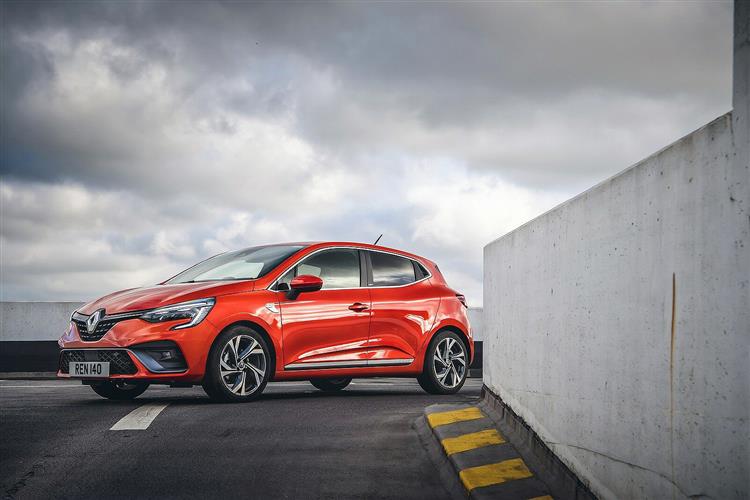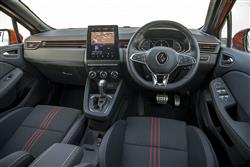HY FLIER? (some text hidden) --NONE--
By Jonathan Crouch
Introductionword count: 68
Hybrid technology has often been decreed too pricey for the supermini segment, but in 2020, Renault attempted to democratise it with this car, the Clio E-TECH Hybrid, a version of its fifth generation Clio supermini. It was a little pricier than an ordinary Clio but the French brand hoped early buyers would be impressed by impressive efficiency figures, plus the 'EV' option that gave limited all-electric driving range.
Modelsword count: 5
5dr Supermini (1.6 E-Tech hybrid)
Historyword count: 250
Back in 2020, Europe at last gained a hybrid-powered supermini to take on the Asian brands - and this was it, Renault's Clio E-TECH Hybrid. There was an awful lot of technology to get to grips with here, but the bottom line was that the French manufacturer was here offering a really credible alternative to diesel power more affordably than any other hybrid supermini maker had managed to do before. And there's a real ongoing need for that. Europe now has the world's strictest emission regulations, requiring a 95g/km across-the-board range average for small cars which it simply isn't possible for a manufacturer to meet without electrifying a large number of its engines. Prior to 2020, all that was available in that regard in the small car market was the Toyota Yaris self-charging Hybrid and a handful of EV models that hardly anyone bought. That's got to change - and it's going to. Unlike the E-TECH PHEV Hybrid versions of Renault's slightly larger Captur and Megane models, this one's a hybrid of the self-charging sort, rather than being a plug-in. But thanks to its F1-infuenced engine technology, it's still capable of diesel-like returns that closely match those of its two close supermini segment full-hybrid rivals, the Honda Jazz and the Toyota Yaris. The Clio E-TECH Hybrid sold in its original form until mid-2023, when it was significantly facelifted and became the only Clio model on sale in the UK. It's the pre-facelift versions of this car we look at here.
What You Getword count: 866
Apart from the badge work, there are no visual differences to mark the Clio E-TECH Hybrid out from standard variants in the range. Which means the look is just as with any other MK5 Clio - a slightly more expressively styled design than others in this model line. At the front, sculpted ribs on the bonnet flow down into a wide central grille and LED tusks curve out from the full-LED headlamps in a C-shaped stylistic flourish that one writer reckoned reminded him of a fairground version of Salvador Dali's moustaches. And from the side? Well it's possible you might not initially notice that this, the only body style on offer, is a five-door hatch. The gloss black rear door handles are, after all, rather artfully hidden in the C-pillar, giving the silhouette a sportier three-door look. The curvy creativity continues at the rear too, where the tail lights feature a C-shaped 3D illuminating signature. A long, thin brake light is fitted at the top of the tailgate glass and there's a further 'E-TECH' badge on the boot lid. But of course what's more important is the stuff you can't see, this MK5 model's stiff, sophisticated CMF-B ('Common Module Family, B'-segment) chassis structure, fashioned from high elastic-limit steel and designed from the outset to accommodate this electrified drivetrain. When we first sampled this MK5 Clio's considerably upgraded cabin, we pronounced it to be un-bettered in the segment for style and quality feel. For this Hybrid model, it gains E-TECH badging and subtle blue detailing running the width of the interior in the air vents and around the gear lever. Otherwise, the ambiance is much as you'd find in any other well specified Clio, with soft-touch trimming, tactile touch-points, smart piano key switches and supportive enveloping seats. The need to incorporate various extra e-functions in the 'EasyLink' centre-dash portrait-format screen means that it must be of at least 7-inches in size with a Clio Hybrid - and ideally you'd get yourself a trim level featuring the larger 9.3-inch monitor. This adds the finishing touch to what Renault's tried to do here, feeling satisfyingly sophisticated as you poke, pinch and swipe your way through menus for things like Navigation, 'Apple CarPlay'/'Android Auto' smartphone-mirroring, apps, Multimedia options and a decent quality DAB audio system. The instrument binnacle can also be quite colourful because you have to have virtual dials with a Clio Hybrid. That's so as the various extra e-drive read-outs can be incorporated, these sitting within the 7-inch colour screen, which, at the top of the range, could be upgraded by original buyers to a wider 10-inch monitor. We weren't especially impressed by the space provided in the back when we first tested the conventional version of this model - and we weren't in this E-TECH version either, though at least the hybrid system's been packaged in such a way as not to detract further from the knee, leg and head space available. One tall-ish adult can just about sit behind another - and you wouldn't really be wanting to do that for very long, room for knees and legs being at something of a premium. Headroom isn't great either, thanks to the somewhat swept-back roof line. As one writer pointed out, overall it's all rather more 'Asterix' than 'Obelix'. But does that matter, given that for the majority of buyers, these rear seats will be used only occasionally for adults and more regularly for children? Only you can decide. There are no versatile seat base gymnastics like you'd get in a rival Honda Jazz, but Renault provides seat back pockets, reasonably-sized door bins, a coin recess in the door pull and overhead coat hooks. The comma-shaped front seat headrests improve your view forward, plus there's a reasonably low centre transmission tunnel that'll make the carriage of three small-to-medium folk a little easier. ISOFIX child seat fastenings feature on the outer two seats and there's easy access to the bin behind the handbrake if you've got stuff you need to stash away. In the top-spec 'RS Line'-spec model, there's also some nice trimming to take your mind off the rather compact surroundings, with twin-colour door stitched and red trimming for the upholstery and the seat belts. We'll finish with a look at cargo space. The standard Clio atones for its somewhat restricted rear seat surroundings by somehow managing to serve up the largest boot in the supermini segment. Well you don't get that here, the usual 391-litre capacity falling to 301-litres in this case thanks to battery pack positioning beneath the cargo area floor. Still, that's only 3-litres less than you'd get in a Honda Jazz and it's 15-litres more than you'd get from a Toyota Yaris. Otherwise, it's as you'd get on any other Clio. There's quite a high boot lip to lug your stuff over and you have to do without an adjustable-height boot floor. But four tie-down points are provided, along with a couple of bag hooks and, unlike in a rival Honda Jazz, there's enough under-floor space to add in a spare wheel. This Clio gets the usual 60:40-split backrest which, when pushed forward, frees up 1,054-litres of capacity across an almost-flat load floor.
To see the full road test text contact us on 0330 0020 227
Pictures (high res disabled)

.jpg)
|
.jpg)
|
.jpg)
| |||
.jpg)
|
.jpg)
|
.jpg)
| |||
.jpg)
|
.jpg)
|
.jpg)
| |||
.jpg)
|

|
Scoring (subset of scores)
Category: Hybrid, Plug-in, Electric & Hydrogen
| Performance | |
| Handling | |
| Comfort | |
| Space | |
| Styling, Build, Value, Equipment, Depreciation, Handling, Insurance and Total scores are available with our full data feed. | |



